02-20 MARCH 2024
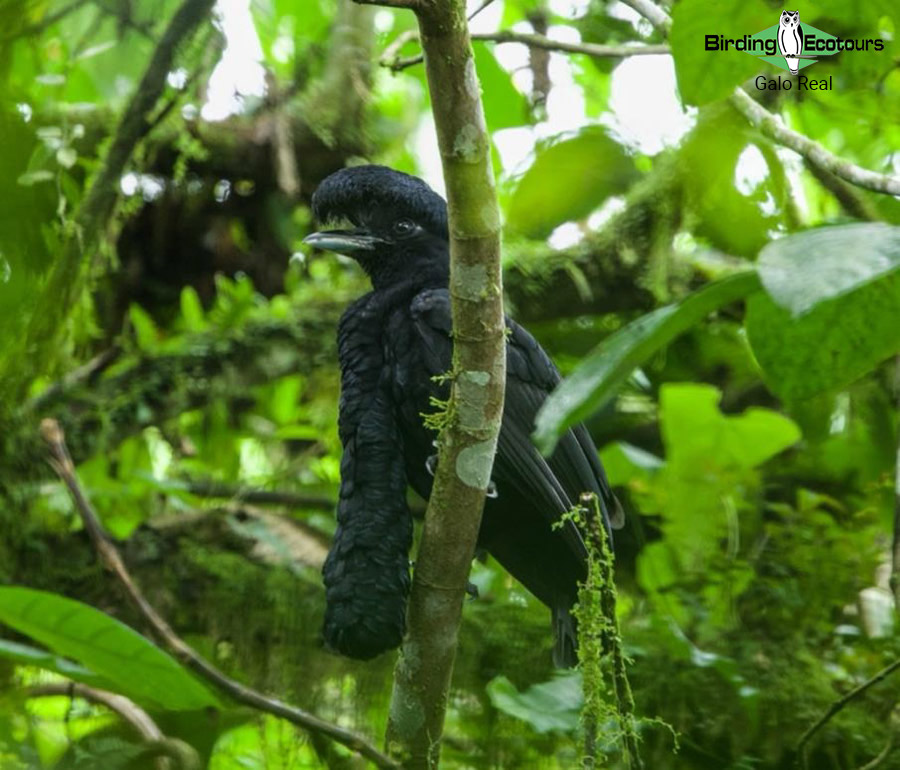
Long-wattled Umbrellabird was a sure trip highlight.
Day 1, 2nd March 2024. Arrival at Quito Airport
The entire group decided to come in a day early to avoid any flight delay issues and to be ready for our flight to Loja the following morning. I picked up Tim, Kay, and Julie at the airport early in the afternoon while Tracy and Joel arrived around 8 pm without any hassle.
Everyone gathered a little before dinner to go over the next day’s plans and hand out Birding Ecotours swag (caps with embroidered logos), checklists, pens, and bars of delicious Ecuadorian chocolate. We enjoyed a lovely dinner and caught up on everyone’s news since visiting Ecuador in 2022 for our Northern Ecuador tour. After going over the itinerary and answering questions about the next few days, we said goodnight and headed off to bed.
The next day everyone rested and birded around the grounds at Hacienda Jimenita. There were several wonderful trails that ran along the Chiche Gorge and the hummingbird feeders and seed trays were quite active.
Day 2, 3rd March 2024. Arrival at Loja Airport and transfer to Buenaventura Reserve
After a delicious breakfast at Hacienda Jimenita and a little early morning birding, we returned to Quito Airport for a short 45-minute flight to Catamayo Airport, located outside the city of Loja. Our good friend and driver, Nestor, was waiting to help us with our luggage as we exited the main gates.
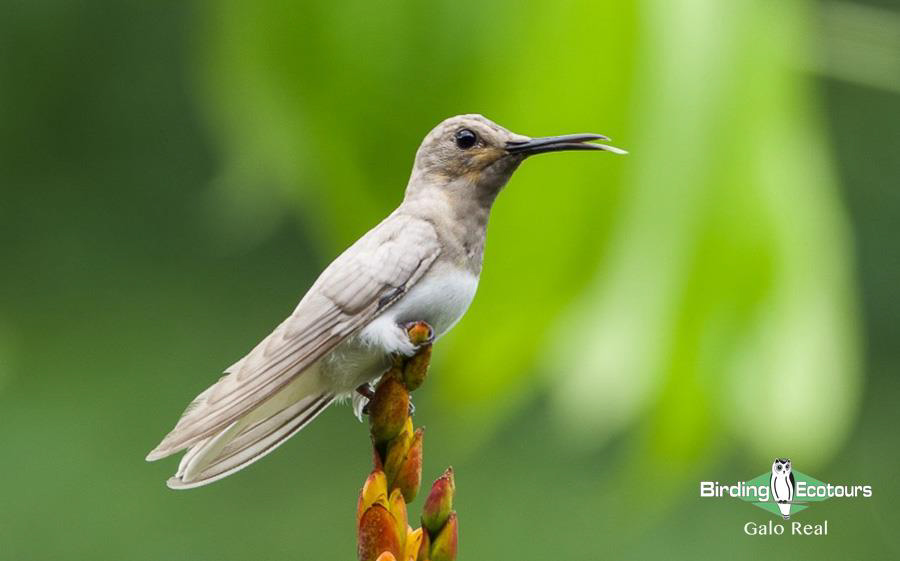
White-necked Jacobin was one of the many hummingbird species encountered on this tour.
Right off the bat, Tracy and Julie spotted a Tropical Mockingbird and a pair of Eared Doves, a great way to kick off our spectacular and memorable birding adventure in southern Ecuador! As we headed west to Piñas we noticed a considerable number of Pacific Horneros, Black Vultures, Smooth-billed Anis and Saffron Finches.
At the Umbrellabird Lodge in the Buenaventura Reserve, located outside the town of Piñas, we were warmly welcomed by the staff. There were a dazzling number of hummers at the feeders: White-necked Jacobin, Brown Violetear, Andean Emerald, Green Thorntail, Green-crowned Brilliant, as well as Bananaquit, Plumbeous Kite, Collared Aracari, Red-masked Parakeet and a pair of Green Honeycreepers. After a delicious lunch, we hung around the lodge, enjoying the mixed flocks that seemed to be nonstop. We ate dinner early, in anticipation of the early morning birding the next day.
Day 3, 4th March 2024. A full day of birding Buenaventura Reserve
After a well-deserved rest and a scrumptious breakfast, we went to look for the Endangered El Oro Parakeet. This beautiful parakeet has a population of less than 1,000 individuals remaining, with their habitat increasingly threatened by ranching. The Jocotoco Foundation has done a great job protecting their small intact habitat and providing nesting boxes.
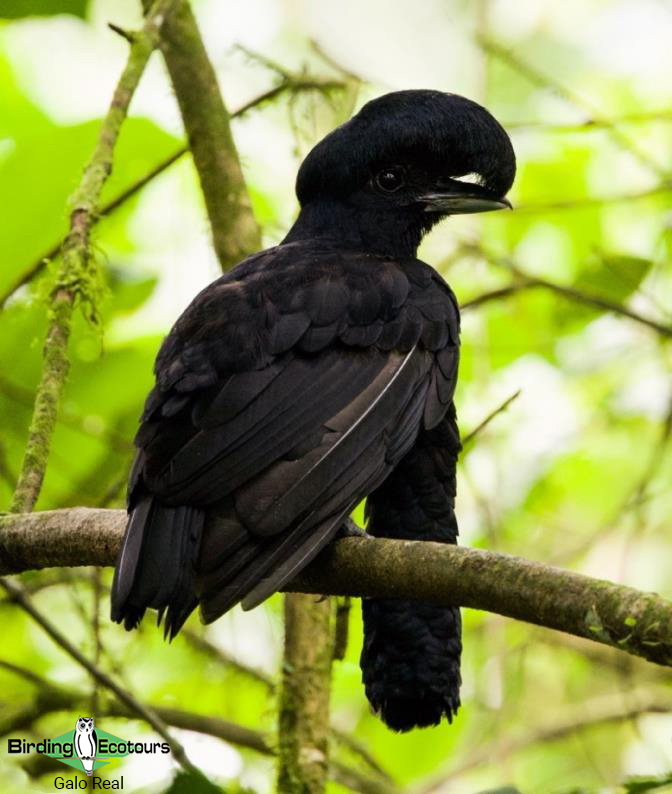
The spectacular male Long-wattled Umbrellabird.
It took a little less than an hour to arrive at one of the nesting spots. Unfortunately, it was drizzling and the parakeets were not very active. We knew this was a possibility, so we decided to stick it out and kept scanning the treetops. While waiting, we saw several Swallow-tailed Kites, a Golden-headed Quetzal, Blue-and-white Swallows, Orange-bellied Euphonias, Bronze-winged Parrots, several House Wrens, a Dusky Chlorospingus, and a group of Rufous-headed Chachalacas.
After almost two hours of patient waiting, I spotted a pair of El Oro Parakeets that seemed to be watching us — people watchers! This pair was fairly distant, so we stuck it out a little longer, and it’s a good thing we did! We spotted another pair, this time closer and in better light. These little beauties made us work for them, but everyone had great looks, and we were proud of our perseverance!
Instead of heading straight back to the lodge, we walked one of the trails to try our luck in the forest. Although the trail was short, we saw Lemon-rumped Tanager, Azara’s Spinetail, Ornate Flycatcher, Golden Tanager and Silver-throated Tanager. Not bad for one morning!
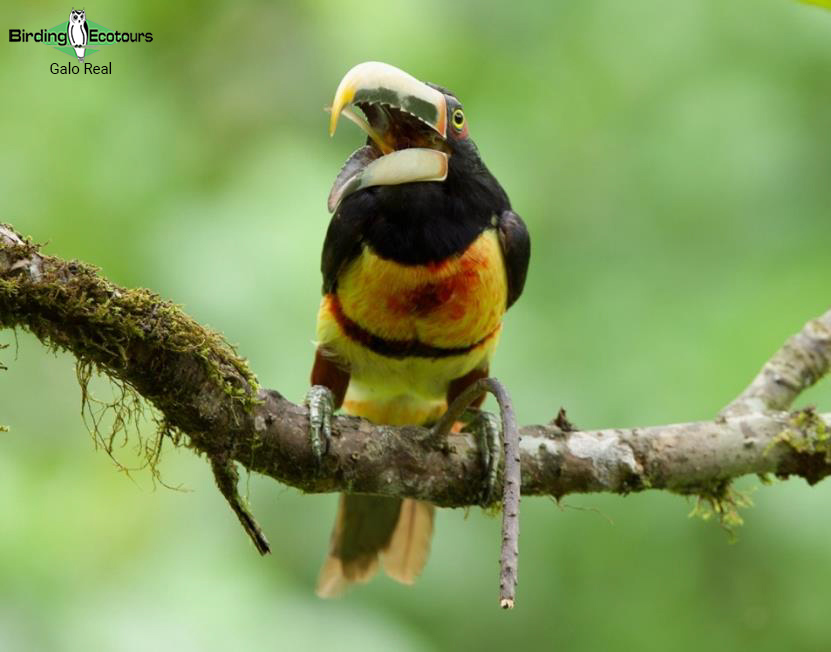
Collared Aracari showed well at feeders.
We then decided to dedicate the afternoon to finding the Long-wattled Umbrellabird. The path to get there was not the easiest, but the group knew what to expect and were pumped to try to find this gorgeous and unusual cotinga. When we arrived at the lek, together with Néstor, we split up and started looking for the bird. Nestor had maneuvered up the path and soon called us as he had spotted some movement in the canopy. After a few comical falls on a very muddy trail, we managed to see an individual perched very calmly, waiting to be photographed. The whole group saw this handsome guy and even managed to take some decent photographs.
Everyone was pumped after a fantastic day; we couldn’t stop chatting about all the great memories in just a short time. The day ended with a toast and a good dinner. Everyone was eager for the next day.
Day 4, 5th March 2024. Cerro Arcos
Today was beyond comparison, full of adrenaline and great birding! Our goal was to reach the Cerro Arcos Reserve, home to the Blue-throated Hillstar, a hummingbird endemicto Ecuador that was only recently identified in 2017. The excitement was palpable. The thought of going to a new spot to see a bird that so few people in the world have seen, was exhilarating!
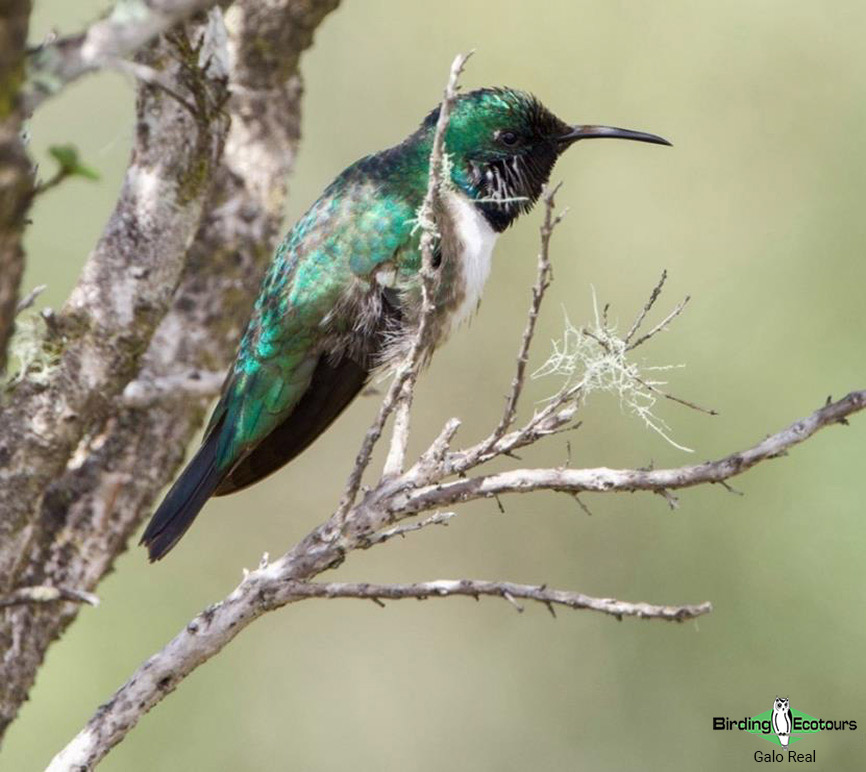
The female Blue-throated Hillstar at Cerro Arcos.
The trip there was long, but we all knew it would be worth it. After traveling almost three hours through the Andes, we arrived at Cerro Arcos. The weather was perfect; it was not too hot or cold, and it did not rain. Upon arrival at a known spot favored by this gorgeous hummer, we settled in, ready to take photographs and have good looks. After about twenty minutes, Joel spotted a female Blue-throated Hillstar. We knew we had a good chance of seeing the male. Tracy pointed out a Brown-backed Chat-Tyrant, and in a matter of seconds, a male Blue-throated Hillstar appeared in front of Tim. He was so excited that he almost forgot to take a photograph, but fortunately, he snapped to it and was able to click off a couple of decent shots. Minutes passed, and I suddenly saw another male perched very close to us. For the next half hour, we had several fine looks, and almost everyone was able to get some good pictures.
As we happily devoured our packed lunch and reminisced on the morning, we watched a Band-tailed Seedeater. Heading back to the van, we saw Azara’s Spinetail, Great Thrush, Masked Flowerpiercer, Black Vulture, and Band-tailed Pigeon.
We arrived at the hotel in the afternoon, and everyone opted to retire to their cabins to rest and wash up. We then gathered to go over our checklist and have dinner. After dinner, despite all being exhausted, we decided to try our luck at seeing Black-and-white Owl. After wandering around for ten minutes, a park ranger from the reserve called us and pointed out an individual perched very close to the cabins. After prolonged good looks, we said goodnight and headed to our rooms for a well-deserved rest.
Day 5, 6th March 2024. Buenaventura Reserve to Jorupe Reserve. Urraca Lodge
This morningwe enjoyed a delicious breakfast at the Umbrellabird Lodge and did some further trail birding. Then we packed up and departed for the town of Macara to the Jorupe Reserve, located outside town.
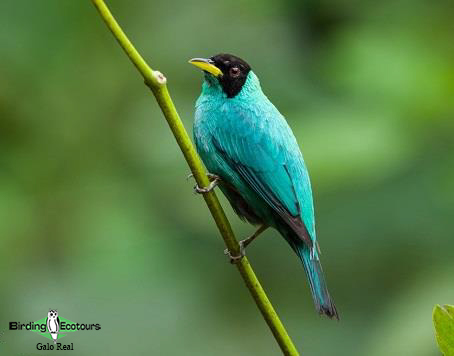
Green Honeycreeper was seen well in the Jorupe Reserve.
Upon arrival, we immediately spotted a pair of Chestnut-backed Antbirds. Further up the trail, we noticed a large bird perching in front of us, and to our surprise, it was a male Long-wattled Umbrellabird!After a few more steps, a small flock approached, and we were ready! First, a pair of Bay Wrens, then several Green Honeycreepers, Golden Tanagers, Silver-throated Tanagers, a Buff-rumped Warbler, Buff-throated Saltators, and, to our surprise, a Choco Toucan. Soon after, a Yellow-throated Toucan appeared and,high in the sky,a Plumbeous Kite. Another flock crossed, with many of the same species, but this time, we picked out Black-faced Dacnis, Yellow-throated Chlorospingus, and a gorgeous Speckled Tanager, which was a complete surprise since only a few records of this species exist at the reserve. Personally, I was very excited because it was a lifer for me. After everyone had a good look, we continued down the trail and back to the lodge.
In a short time, we had seen almost ten new species for our list. Feeling content after a nice morning of birding, we said our goodbyes to the lovely staff and began our trip east to the Jorupe Lodge.
It was then the five-hour-long haul from Buenaventura to Jorupe, however, because we were mentally prepared, we enjoyed watching the topography and vegetation change from lush foothills and rainforest to dry Andean forest. Along the way, we stopped for lunch near Huarchapamba. This area is known for growing excellent high-elevation coffee. The restaurant we stopped at is known for serving Ecuadorian food, made from locally sourced organic products. There was more than one comment about how delicious the food was, and everyone appreciated the traditional and delicious cuisine from the area. After stretching our legs and eating, we were ready to get back on the road to reach Jorupe in time for some afternoon birding.
As we pulled up to the gates, two friendly faces were waiting for us, Jocotoco’s longest-standing park guards, Geovani and Leo. I was glad to see them; they always know the latest spots to see those elusive endemics! After we said our hellos, we continued up to the main lodge, where the remaining staff were waiting for us.
After settling in at Jorupe’s Urraca Lodge (Jay Lodge), we met up to check out the feeding stations. The gorgeous and gregarious White-tailed Jays and Eared Doves were enjoying a banquet of papayas, and they couldn’t have cared less that we were so close.
After a lovely dinner, we said goodnight and eagerly headed to our cabins for a good night’s rest.
Day 6, 7th March 2024. Birding Jorupe Reserve Urraca Lodge
It was drizzling as the day dawned, but this didn’t dampen our eagerness to get out the door and start birding. In fact, a little rain in the dry Tumbesian forest results in great birding later. First, we checked the feeders around the lodge. Groups of White-tailed Jays were the first to visit, and then a couple of Scrub Blackbirds joined the buffet. Suddenly a male Pale-browed Tinamou appeared on the ground! We were hoping to see this species of tinamou, but we didn’t expect to see it so quickly! Everyone saw this gorgeous and unusual creature well and got good shots.
After breakfast, the rain had stopped, so we went out on the reserve’s road, hoping to see some flocks as they crossed the road. This was the right decision. Besides several birds we had seen previously, we also saw Ecuadorian Trogon, Pale-legged Hornero, Fasciated Wren, Grey-and-gold Warbler, Plumbeous-backed Thrush, Collared Antshrike, Rufous-browed Peppershrike, Ecuadorian Piculet and, surprisingly, a Pacific Pygmy Owl! While waiting for the sun to go behind the clouds, I spotted something large and white soaring in the sky. As the blur moved closer, we realized it was a pair of King Vultures and a Short-tailed Hawk!
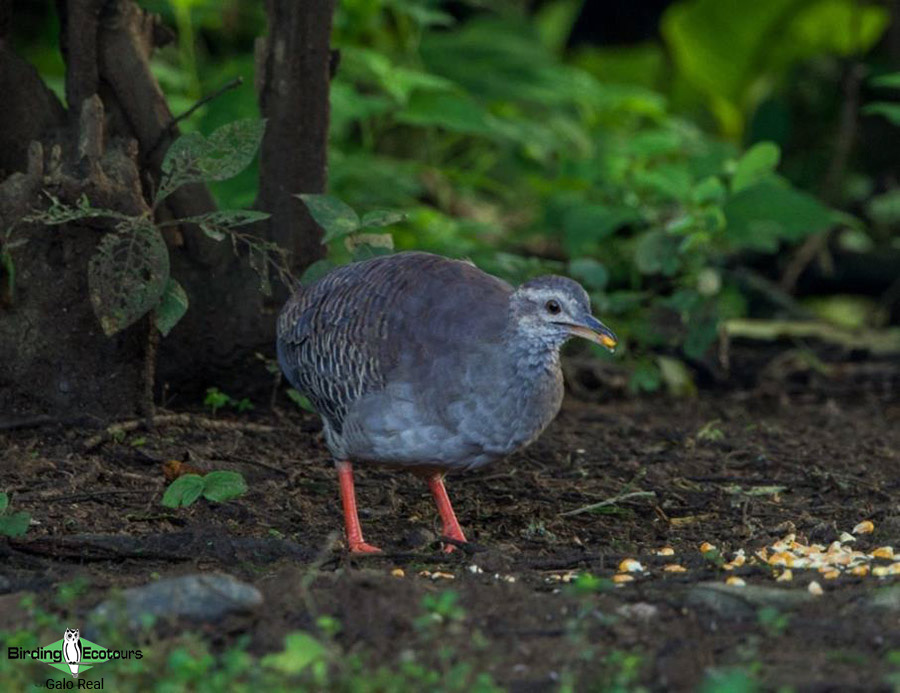
Pale-browed Tinamou proved relatively easy to find.
As the day warmed up and activity slowed a bit, we headed back to the lodge to check out the feeders before lunch. The same Pale-browed Tinamou was hanging out, as well as Amazilia Hummingbirds and White-tipped Doves.
In the afternoon, we rested during the hottest part of the day, since the birds were doing the same. In the late afternoon, we went back out to the road again. Within minutes, we spotted a couple of Scarlet-backed Woodpeckers, a Squirrel Cuckoo, Plumbeous-backed Thrush, and a Wedge-billed Woodcreeper. Then, as if someone had turned the volume off, everything became very quiet before it suddenly started to rain hard. We high-tailed it back to the lodge to watch the feeders and relax after a very successful day of birding.
Day 7, 8th March 2024. Birding the Macara and Zapotillo roads
After breakfast, we boarded the van and headed to the town of Zapotillo. This small community is surrounded by excellent patches of intact tropical dry forest. The plan for the morning was to bird around some well-known stomping grounds of several Tumbesian specials, which are often hard to find elsewhere.
From Macara, we took the road heading west, and a few minutes later, at an abandoned mine, we stopped at a patch of mature forest. We were greeted by Fasciated Wren, Saffron Finch, Pacific Hornero, Grey-and-gold Warbler, Plumbeous-backed Thrush, Peruvian Meadowlark, and Blackish-headed Spinetail.
At the next spot, we saw Bat Falcon, Scarlet-backed Woodpecker, Pacific Parrotlet, and Boat-billed Flycatcher.
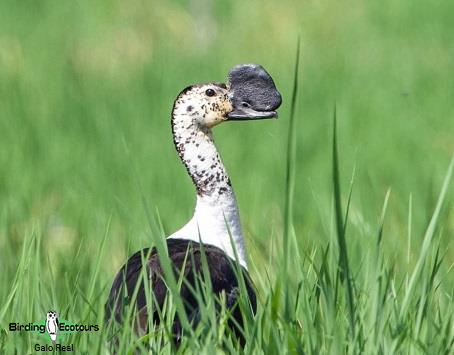
A bizarre male Comb Duck.
Surrounding Zapatilo are many rice fields, which are a favored habitat for Comb Ducks. Upon arrival at the fields, we saw many Roseate Spoonbills and Great Egrets.Within momentsof skimming the fields for this unusual duck, we spotted four males, as well as Savanna Hawk, Crested Caracara, Snail Kite, and what seemed like an infinite number of Chestnut-throated Seedeaters. As we continued along the road and onto a bridge, we saw several Neotropic Cormorants, Spotted Sandpipers, and even more Comb Ducks.
Around noon, the activity slowed down, and so did we! We returned to the lodge for lunch.
In the afternoon, we made our way down to the town of Macara. Since Macara is on the Ecuador-Peru border, we had to pass through a security checkpoint, which is no big deal. After a routine check of our vehicle the border patrol checked our credentials and waved us through. After such a great morning at the rice fields to the west, we decided to visit the fields to the east. Almost instantly, we spotted Croaking Ground Doves, more Comb Ducks, Long-tailed Mockingbirds, and several Ringed Kingfishers. We then ventured up onto the international bridge that goes over the Macara River. As we stood on the top of the bridge, with Peru to the south and Ecuador to the north, we saw Neotropic Cormorants, a Striated Heron, and a beautiful Black-crowned Night Heron.
Early evening saw us return to the hotel for dinner. Our plan was to go owling if the weather permitted. After a delicious dinner, we headed out, and the first owls we heard were a couple of Spectacled Owls, but they were very shy and we didn’t see them very well. Then we called the Pacific Pygmy Owl, “who” (no pun intended) responded immediately. As we walked a little further towards the parking lot, Julie managed to spot a very quiet and solo Pacific Pygmy Owl. What a great sighting! We all got spectacular looks at him, and Tim was able to take some gorgeous photographs. Happy but exhausted, we retired for the evening in anticipation of an early easterly departure to bird early at the Utuana Reserve.
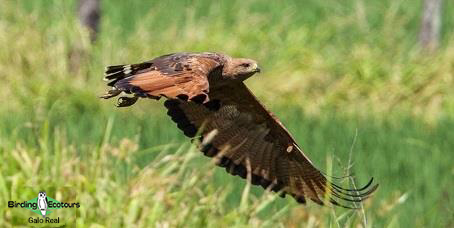
Savanna Hawk near Zapatilo.
Day 8, 9th March 2024. Exploring the Sozoranga road and the Utuana Reserve
Today, we were up and out the door early, eager to get to the Jocotoco’s Utuana Reserve. This wet montane elfin forest reserve has several special hummers that visit the feeders, such as Purple-throated Sunangel, Rainbow Starfrontlet, Speckled Hummingbird, and Masked Flowerpiercer.
We also spotted the Black-cowled Saltator as soon as we arrived at the Utuana Reserve. A Streak-throated Bush Tyrant and an Eared Dove made an appearance before we continued to Loja.
On the way, we made a series of productive stops. At the first spot, a gorgeous and very cooperative Black-crested Tit-Tyrant made an appearance, plus Plumbeous Rail, Saffron Finch, Rufous-browed Peppershrike, and a spectacular Summer Tanager. As we rounded the bend to Catamayo, we pulled over at one of my go-to birding spots, and Tumbes Sparrow, Croaking Ground Dove, Long-tailed Mockingbird, and some cute Pacific Parrotlets seemed to be waiting for us.
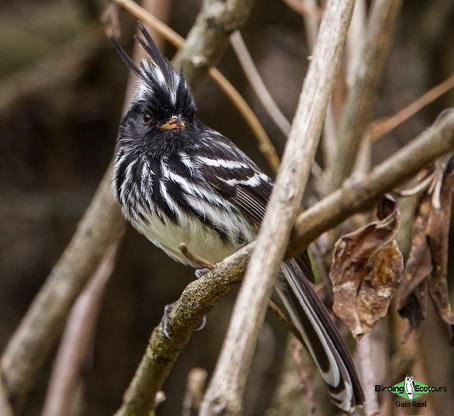
A very obliging Black-crested Tit-Tyrant.
Upon arrival at Loja, we went straight to our hotel. The Grand Victoria, located in the colonial city center, is always very comfortable. Before dinner, we checked our lists and talked about what to expect the next day. Dinner was delicious, and we all went to bed content.
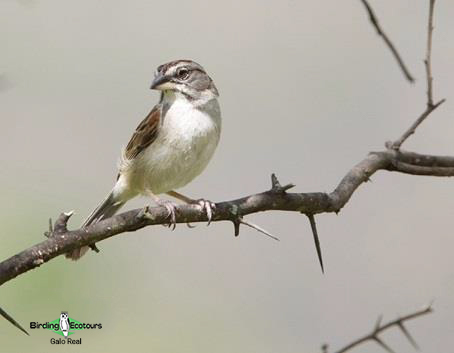
Tumbes Sparrow showed without too much difficulty.
Day 9, 10th March 2024. Exploring Podocarpus National Park and Vilcabamba
We checked out for an early departure to the Cajanuma entrance of Podocarpus National Park. This is one of the largest parks in Ecuador and covers several different habitats with significant elevation changes. This morning, we were exploring the southern cloud forest area near Vilcabamaba. At first, we assumed it would be one of those typical cloud forest birding experiences where one knows there is a lot of activity, but because of the clouds and wind, one cannot see anything. Happily, we immediately spotted Plain-tailed Wren and Chusquea Tapaculo,despite the inclement weather.
Although conditions were not ideal, we saw a nice mixed flock, with several previously seen species, as well as Cinnamon Flycatcher, Pearled Treerunner, and Masked Flowerpiercer. As late morning crept up on us, we headed down to the town of Vilcabamba to bird there for a while before lunch. From the ranger’s station to Vilcabamba, the topography changed quickly to Andean dry forest. After visiting several spots to locate the elusive Elegant Crescentchest,we stopped at a particular spot, and one individual seemed to be calling right next to us. No one could figure out where, and then, without warning, he came out, turned around, and disappeared again within a split second.Everyone saw a flash, some better than others, but that was all we got this time around! That bird made us work for those glimpses!
We were ready for lunch a little after noon, so we meandered back to the town center of Vilcabamba and had a nice easy meal at a local restaurant. We then made our way southwest to the Tapíchalaca Reserve and the Casa Simpson Lodge, where we were going to be spending the next two nights.
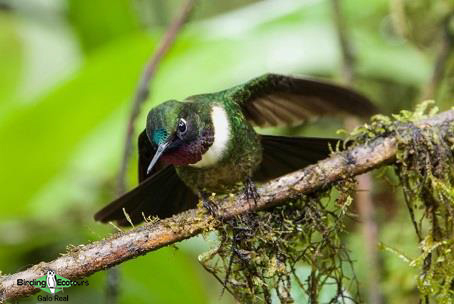
Amethyst-throated Sunangel was seen well at Casa Simpson Lodge.
After a two-hour drive, we arrived at the reserve. The staff eagerly showed us to our rooms, and before long we were checking out the hummingbird feeders and fruit trays. The entire group was mesmerized and ecstatic with the activity, which included Collared Inca, Flame-throated Sunangel, Bearded Guan, Chestnut-breasted Coronet, and Amethyst-throated Sunangel.
As night approached, we checked our lists before dinner and discussed the plans for the next day, with thoughts of Jocotoco Antpittas jumping in our heads!
Day 10, 11th March 2024. Tapichalaca Reserve and Valladolid Road
After a rainstorm that lasted all night, we awoke to find no electricity throughout the lodge. However, there was a warm and delicious breakfast waiting to console us. As we ate, we contemplated our “strategy” for the day. No one felt comfortable making the hike up a slippery hill to see the Jocotoco Antpitta,even though the trail was in good condition. Since the chance of seeing the antpitta in the rain was slim, I suggested flip-flopping our schedule. We decided to try our luck around the town of Valladolid, located 45 minutes by vehicle lower down the slope, around 3,300 feet (1,000 meters) above sea level, and closer to the Peruvian border. The Valladolid River flows into the Marañon River, which is an important tributary of the Amazon. We unanimously agreed to venture down lower, where the storm seemed to have already passed, and check out the Valladolid River Valley.
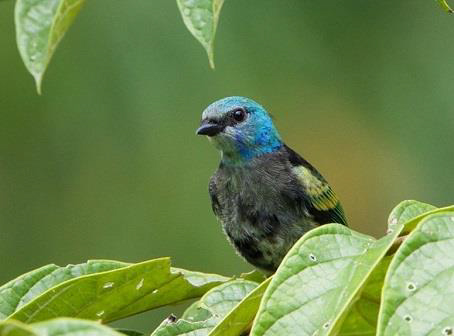
The attractive Blue-necked Tanager.
Our first stop was at the bridge to Valladolid, where we soon spotted a small mixed flock of Blue-necked Tanagers, an Azara’s Spinetail, a Blue Dacnis, several Silver-backed Tanagers and even a Torrent Tyrannulet!Everyone was excited about what we had just seen, when suddenly Julie commented that she was looking at a grey bird with a black face. I instantly knew she had spotted a Black-faced Tanager!This is a tough tanager to find, and everyone got a great look at it.
We continued birding along the road to Peru, finding Rufous-fronted Thornbird, Maranon Thrush, Blue Dacnis, Paradise Tanager, Common Tody-Flycatcher, and several Blue-headed Parrots.
Around noon, we returned to the lodge, ready for lunch and a small siesta. We all met up shortly afterward to check out the hummingbird feeders and see what else was coming to the tanager feeders. We saw the usual Collared Inca, Amethyst-throated and Flame-throated Sunangels, Chestnut-capped Brushfinch, and Bearded Guan. We then walked around the lodge and had great looks from the parking lot at a pair of Hooded Mountain Tanagers.We decided to try our luck walking along the road, and Julie quickly spotted a silhouette on top of a tree. I placed the scope and, to our surprise, it was a Grey-breasted Mountain Toucan! Tracy, who loves toucans, was ecstatic and, funnily enough, had just commented about not seeing too many toucans on the trip, and now we were up to three species of toucans!
Shortly afterward, we saw two more toucans crossing the road and this time we wanted to check whether they were perching nearby and if we could see them better. We tried several times but didn’t succeed. The only thing that appeared was a male Great Thrush. As the sun started to go down, the rains started up again, so we scrambled back to the lodge to check our lists, have dinner, and a good night’s sleep.
Day 11, 12th March 2024. Birding the Zamora Road to Copalinga Lodge
Everyone was rearing to go and in great spirits this morning since it was not raining, meaning we had a good chance of seeing the infamous Jocotoco Antpitta. After breakfast, we started down the Quebrada Honda Trail, which runs through the very diverse cloud forest habitat of the southeastern foothills of Ecuador. The Tapichalaca Reserve forms a very important ecological corridor with Podocarpus National Park. After a short walk, we took the path leading to the guard station since the antpitta feeding station is located along the way. After a few steps, we heard a Golden-plumed Parakeet family. However, the weather was a little cloudy, so we moved on, and we were ready to get to the antpitta spot! When we arrived, Franco, the oldest park ranger in the reserve, was waiting for us with a nice cup of worms! Once we got settled, a small mixed flock passed in front of us with several species, including Lacrimose Mountain Tanager, Blue–and-black Tanager, and Slate-throated Whitestart. Franco began whistling, and before we knew it, a Jocotoco Antpitta appeared and went straight for the worm offering that Franco had spread out. Once we all had many great looks and had taken numerous photographs, the antpitta darted out of sight.
We returned to the lodge feeling satisfied and ready to depart for Copalinga. What a great way to start the morning and say goodbye to Tapichalaca.
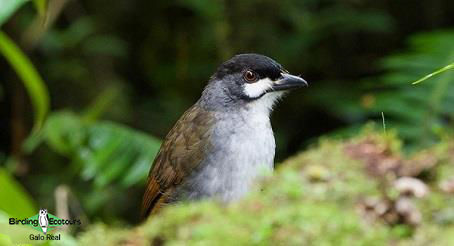
The star of the show, Jocotoco Antpitta.
After packing up and checking out, we started the four-hour trip northeast to Copalinga Lodge, located outside the town of Zamora. Our plan was to stop in Vilcabamba at a strategic rest area with a nice coffee shop and have our packed lunch there before continuing to Copalinga. The drive was uneventful and easy. We arrived at the lodge, checked in, unpacked, and then immediately met up to feed the Grey Tinamou.
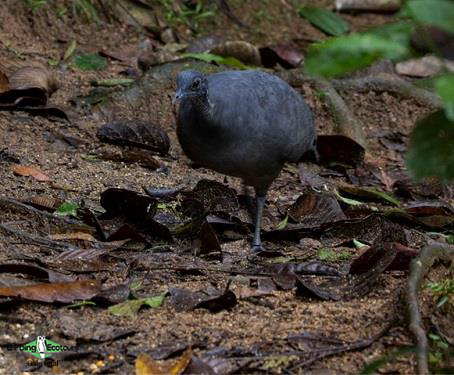
Grey Tinamous are fed near our lodge and showed well for us.
After a short twenty-minute hike, we came to the blind on the trail to wait for the tinamou. While everyone found spots, I poured corn in certain spots up ahead on the trail and then quickly ducked behind the blind as well. We waited for a long time behind the hide, and the only birds that appeared were a couple of Orange-billed Sparrows. The group began to feel anxious and started to get restless, but I was very hopeful. Almost like magic, I suddenly spotted a solo Grey Tinamou approaching us on the other side of the path from our hiding place, and I notified the entire group. They quickly returned to their seats just in time to watch the tinamou devour the corn. We were all thrilled. It was hard to believe that we had already seen this elusive creature within just a couple of hours of arriving at the lodge, and this was the second species of tinamou seen in a week!
As evening approached, we walked back to the lodge to check our list and have dinner.
Day 12, 13th March 2024. Birding Podocarpus National Park and Copalinga
Today’s plan was to have an early breakfast and then bird the immediate environs of the lodge in the morning. From the parking lot, we spotted several very vocal Crested Oropendolas, and in the verbena flowers, we saw Violet-headed Hummingbird, Black-throated Brilliant, and Wire-crested Thorntail right off the bat. Then, within moments, we spotted Lineated Woodpecker, Wedge-billed Woodcreeper, Paradise Tanager, Swallow Tanager, Blue Dacnis, and Red Pileated Finch!
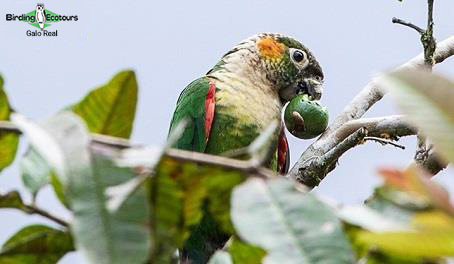
White-breasted Parakeet happily feeding in the afternoon light.
As we were birding, a large troop of White-faced Capuchin monkeys appeared and stole the show with their curious behavior. We watched them for quite a while, until a heavy rainstorm started, and we took cover in the dining area while lunch was being served.
After our meal, the rain ended, and the forest became active. I informed everyone to get ready because I could hear a mixed tanager flock coming our way! Within moments, Guira Tanager, Paradise Tanager, Golden-eared Tanager, Blue Dacnis, Black-faced Dacnis, and Green Honeycreepers had taken over the trees overhead. We couldn’t believe that in less than fifteen minutes, we had managed to see so many foothill forest gems. Then, without warning, a rain shower came down, and the flock was gone. Since the rain was not going anywhere, we decided to have a rest during the storm and meet up a little later, around lunchtime.
In the afternoon, the sky was blue, a typical eastern slope afternoon after a morning of heavy rains. While waiting for everyone, we watched the hummingbird feeders. Nothing new showed, but Kay and I could hear parakeets in the distance. A flock of White-breasted Parakeets had landed in a tree nearby and were enjoying themselves. By this time, everyone was watching the pandemonium and taking photographs. We hung out, watching the cooperative parakeets for at least half an hour before they took off. Those with cameras walked away with some nice shots from different angles, and the parakeets did not mind us too much.
Although the rain had started up again, the birding was excellent around the dining area, so we decided to stick around the shelter of the lodge. We saw Speckled Chachalaca, Red Pileated Finch, Green Hermit, Grey-chinned Hermit, Olivaceous Woodcreeper, Crested Oropendola, and Plain Antvireo.
Suddenly, the rain started coming down hard, and we opted to go and check our list from the day before dinner.
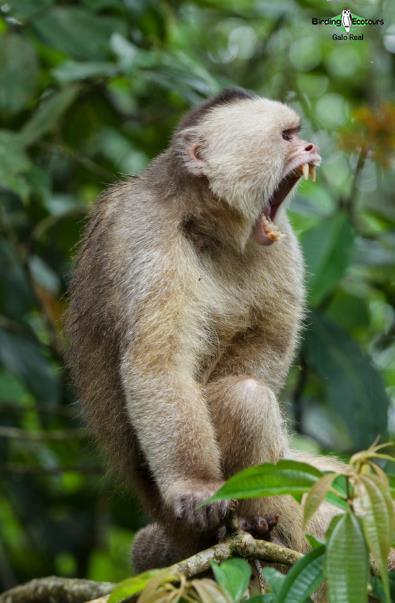
A large troop of White-faced Capuchins were seen well.
Day 13, 14th March 2024. Drive to the Cordillera del Condor and Cabañas Yankuam
We woke up to a beautiful, crisp morning. Around the lodge, the feeders were quite active, so we opted for a little birding around the lodge environs before departing for the northeast to Cabanas Yankuam Lodge, located outside the town of Zamora.
For about an hour, nothing new appeared, but it was nice to stretch our legs a bit before climbing into the van for the 3.5-hour drive ahead of us. We stopped to bird along the way at some strategic spots. The first stop was at the Municipal Canal Area which is surrounded by secondary forest, mostly fruiting trees. Several Black-capped Donacobius were putting on a great display show. We also saw White-eyed Parakeet, Striated Heron, Smooth-billed Ani, Silver-beaked Tanager, Magpie Tanager, Spotted Tanager, and Crested Oropendola. It was a rewarding stop.
We then pulled over for lunch at a small verbena garden, where we were hoping to spot a Spangled Coquette. As we walked in, we noticed that several Blue-tailed Emeralds were feeding on the flowers and before we could sit down, I saw a female Spangled Coquette. Everyone was able to watch this beautiful little female for some time while it visited the different flowers. Others seen in the garden included Violet-headed Hummingbird, Little Woodstar, Glittering-throated Hummingbird, and Wire-crested Thorntail.There were also several Yellow-tuffted Woodpeckers, Roadside Hawk, and Olive-sided Flycatcher.
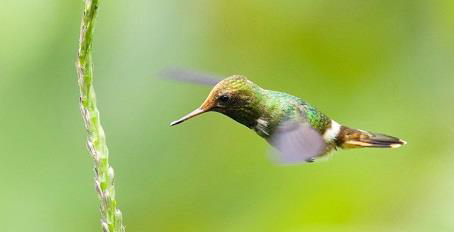
A tiny female Spangled Coquette.
After lunch we drove directly to Yankuam Lodge, located alongside the Nangaritza River. The topography of this area is fascinating, with the spectacular tepui waterfalls flowing into the Nangaritza River surrounded by the Varzea forest floors and cliffs, home to the very rare Orange-throated Tanager.
After arriving at the lodge and settling in, we immediately started searching for the tanager. Within fifteen minutes of walking, we could hear the Orange-throated Tanager’s loud, almost squeaky, calls in the distance. There was a mixed flock passing over, so I told everyone to watch the flock and wait. The first thing we saw was a group of Paradise Tanagers, then Spotted Tanager, Green-and-gold Tanager, Blue-necked Tanager,and, almost as if on cue, a male Orange-throated Tanager started calling very close. I was able to get the tanager in the spotting scope so everyone could get a close-up look. All those with cameras got some great shots of this gorgeous bird.
Once that group moved on, Néstor motioned that he could see another Orange-throated Tanager,and the light was even better in this spot. While everyone was taking photographs, I noticed a Lemon-throated Barbet male watching all the excitement. I moved the spotting scope in the direction of this barbet, and the entire group saw it without any problems. We really lucked out seeing these two species within an hour of arriving. Since we were on a roll, I decided to venture a little further and try for the gorgeous Purplish Jacamar. Sure enough, with just a couple of playbacks, a female perched fairly close to us.
The sun started to go down, so we decided to head back to the lodge for a quick shower before checking the list. We were all excited that we could add six new species to our list!
Day 14, 15th March 2024. Cordillera del Cóndor
After breakfast, we headed to the nearby Maycu Reserve. This private reserve is located at the base of the Condor Cordillera mountain range. The tepui cliffs create a unique ecosystem that is very rich and diverse in species.
We traveled a few kilometers and stopped at a known White-plumed Antbird spot. After waiting a few minutes, we had no luck, but instead, a male Green-backed Trogon sang behind us and we were all able to get great looks at him. We all wanted to try for the Orange-throated Tanager again, so we ventured further up the road and came across a small mixed flock with Paradise Tanager, Silver-beaked Tanager, Spotted Tanager, Green-and-gold Tanager, Blue Dacnis, and Ornate Flycatcher. Along the way, we also heard a couple of Little and Undulated Tinamous, but noOrange-throated Tanagers!
As the morning began to warm up, we decided to keep birding from the van. Throughout the morning, we saw Black Caracara, Black-capped Donacobius, Black-crowned Tityra, Swallow-tailed Kite, Yellow-tufted Woodpecker and Many-banded Aracari. Around noon, we returned to the lodge and had lunch and a short siesta since the sun was extreme and nothing was moving.
By the afternoon, the sun had gone down a bit and life was stirring again. We met up in the parking lot and watched a family group of Paradise Tanagers. Then I heard a Purplish Jacamar singing very close, the same species we had seen the day before. He flew up very close to us and the whole group managed to get another good look at this beautiful and local jacamar.
We continued along the road while scanning the canopy. The activity was good, and in a few minutes, we saw a group of Violaceous Jays, Boat-billed Flycatcher, a couple of Blue-necked Tanagers, a Lineated Woodpecker, many White-banded Swallows, and a Black-crowned Tityra. Then, like magic, a Spangled Cotinga appeared. Incredible.
It was already starting to get dark, so we made our way back to the lodge for dinner and the night.
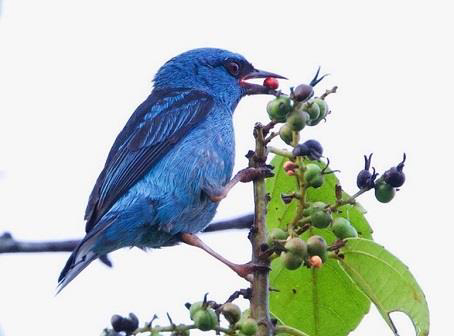
A colorful Blue Dacnis.
Day 15, 16th March 2024. Maycu Reserve and transfer to Loja
Before and after breakfast, we birded the immediate area of the lodge. At first, it was pretty foggy, and we did not see much, but then the fog started to burn off, and we noticed Grey-capped Flycatcher and Tropical Kingbird, then Swallow Tanager, Masked Tanager, several Paradise Tanagers, a Black-billed Thrush and, out of nowhere, a Channel-billed Toucan appeared. Tracy, as well as the rest of the group, were ecstatic.
It was time to get on the road and travel back to Loja, giving us time to bird along the way. We made a couple of stops and saw Green and Ringed Kingfishers, Speckled Chachalaca, Roadside Hawk, and Silver-beaked Tanager.
Near the outskirts of Zamora, we tried to find a Blackish Rail one last time. The weather was scorching, and we didn’t see much. I headed to a place where I had seen the rails before. We called them and waited a few minutes with no response. Then, right before trying to call again, two individuals sang, and one of them crossed right in front of us; then, two males came out of the reeds and moved very close to us, giving everyone time to look at the rail’s beautiful plumage. Check!
A little before noon, we arrived at the city of Loja and had lunch downtown before heading to our hotel. We had a full day, and everyone opted to rest for the remaining afternoon. Early in the evening, we met up to check the list and have dinner.
Day 16, 17th March 2024. Exploring Cerro Acanana and transfer to Santa Isabel
After an early breakfast, we checked out and drove for two hours to the Arcanana Reserve, located near the town of Saraguro. The Arcanana Reserve protects a unique patch of inter-Andean forest. We spotted a Glowing Puffleg within moments of entering the reserve. The whole group was able to get good looks at this new hummingbird for the list, a great way to start the day. Although it was starting to get foggy, we managed to spot White-crested Elaenia, White-bellied Woodstar, Yellow-breasted Brushfinch, and Spectacled Whitestart.
Around noon, we drove to the town of Saraguro to have lunch. After lunch and a stretch of the legs, we jumped back in and Nestor drove us two more hours to Santa Isabela, to our hotel located in the Yunguilla Valley. After checking in, we walked around the gardens before checking the list and having an early dinner.
Day 17, 18th March 2024. Birding Yunguilla Reserve and heading to Cuenca
Today’s objective was to visit Jocotoco’s Yunguilla Reserve, established to protect the small remaining habitat of the Pale-headed Brushfinch, and see this endemic species. The hotel was able to provide us with an early breakfast so we could be at the reserve by 7 am. Ángel, the reserve’s park ranger, was waiting for us at the main gate. He then led us to where he had put food out for the finch. Within moments, a Grey-browed Brushfinch appeared, and then the Pale-headed Brushfinch!We couldn’t believe it; we hardly had to wait at all.Then, to our surprise, a Chestnut-crowned Antpitta also came in for a bite. Flame-throated Sunangel and Amazilia Hummingbird were visiting the flowers around us.
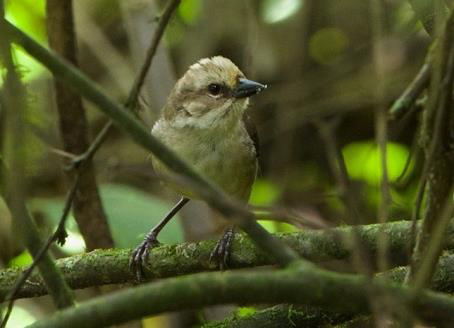
The rare Pale-headed Brushfinch.
Since we had all seen the target birds very well, we opted to make our way to our lodge north of Cuenca. We broke up the two-hour trip with birding along the way. At one stop, we were surprised to see a White-banded Tyrannulet, White-throated Tyrannulet, Spectacled Whitestart, Masked Flowerpiercer, Tufted Tit-Tyrant, and a female Violet-throated Metaltail!
The change in elevation today was not drastic but we could all feel it. As we checked in, we drank tea and warmed ourselves next to the fire in the main area. After settling into our rooms, we met up later to check the list and savor an exquisite dinner.
Day 18, 19th March 2024. Cajas National Park full day
Today, we spent the whole day at Cajas National Park. After breakfast we quickly got into the van and drove to the park entrance, where there is an excellent spot for Tit-like Dacnis, and chances were high that we would see this bird.
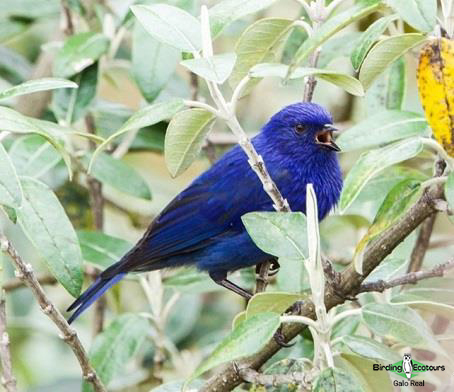
Tit-like Dacnis in the Cajas National Park.
When we arrived, the park was not yet open, so we decided to check out the polylepis trees around us. I spotted a pair of Giant Conebills, a nice sight for everyone. Nestor spotted an Ecuadorian Hillstar flying near us; then several Stout-billed Cinclodes appeared, along with a Plumbeous Sierra Finch.
After the gates opened, we drove in and the guard checked our credentials before allowing us to continue up to the “Toreadora” lagoon. This lagoon is one of the Tit-like Dacnis’favorite stomping grounds. While walking along the trail around the lake, we managed to hear an individual singing inside some bushes. While we were waiting, a male Blue-mantled Thornbill appeared very close to us which was very cooperative and allowed everyone to take photographs. Suddenly, the Tit-like Dacnis popped out of the bush, which was perfect for everyone to get good looks and nice photographs of this gorgeous bird. He hung out for several minutes. Then, a Tawny Antpitta appeared very close to us. We all stayed quiet; I did not even want to breathe. What a beautiful antpitta! We were shocked at how bold he was.
Upon reaching the entrance to the trail that leads to the lagoon, Néstor spotted a small group of Turquoise Jays, which everyone was excited to see. After the jays left, we followed the path, and within a few minutes, we managed to see a group of Russet-crowned Warblers and a single Shining Sunbean. This wet, high-elevation forest is considered pre-montane forest and is very unique due to the gnarly wind-blown polylepis trees and carpet-like plants. Once we arrived at the lagoon, we immediately saw a couple of Andean Ducks and an Andean Coot.We kept walking around the lagoon to see if we could spot the recently split Ecuadorian Rail but had no luck. As lunchtime crept up on us, we started back to the van and a Mountain Velvetbreast crossed in front of the group, and then a Spectacled Whitestart. We couldn’t stop talking about everything we had seen this morning, and before we knew it, we were back at the lodge ordering our lunch.
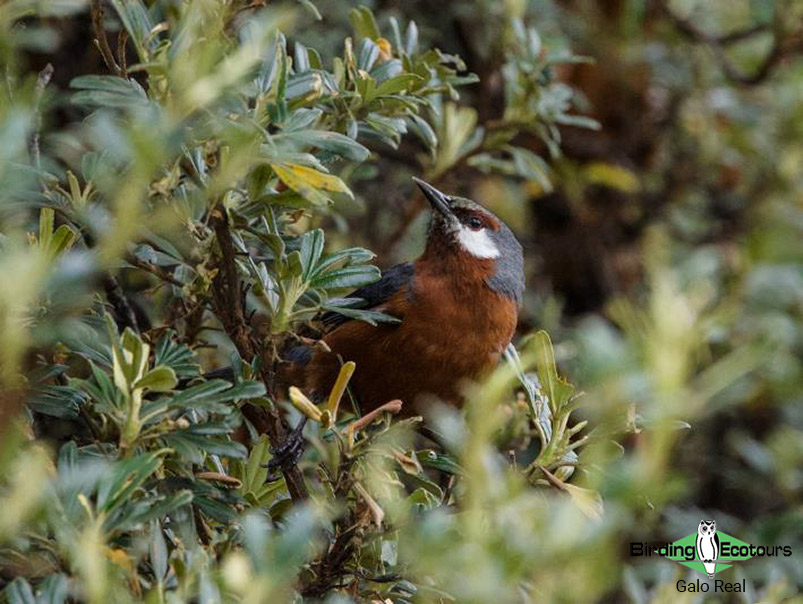
The smart-looking Giant Conebill.
In the afternoon we met up to walk down the lodge’s paths to see what we would see. The weather was a little windy, but we nevertheless decided to stay a little longer, and we saw Brown-bellied Swallow, Great Thrush, and an Andean Gull. Suddenly, the temperature dropped and we all opted to go back and get ready to check the list and then have dinner.
Day 19, 20th March 2024. Hosteria dos Chorreras and flight back to Quito
This morning, we had the chance to bird around the lodge before traveling to Cuenca for our flight back to Quito.The sky was clear, and the weather was nice, so we walked the trails around the lodge. We spotted Yellow-breasted Brushfinch, Spectacled Whitestart, Pearled Treerunner, Mountain Wren, and Blue-backed Conebill. This conebill was new for the trip, putting a smile on everyone’s faces!
After a few hours, we returned to the lodge to check out and head to the airport. Our flight was less than 40 minutes, and before we knew it, we were in Quito, heading to Hacienda Jimenita. The Saffron Finches, Golden Grosbeaks, and Rusty Flowerpiercers were at the feeders when we rolled up. The staff quickly showed us to our rooms so that we could freshen up before our meal.
Before dinner, we checked our list one last time, and we had one last meal together. We talked about the past couple of weeks and how much we had done and seen. We then talked about where we would have our next birding adventures with Birding Ecotours—perhaps the Amazon or Galapagos.
This is a sample trip report. Please email us ([email protected]) for more trip reports from this destination.
